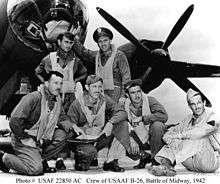James Muri
| Lt. Col. James Perry Muri | |
|---|---|
 Muri (right) with 2dLt Pren Moore in 1942 | |
| Born |
October 19, 1918 Carterville, Montana, United States |
| Died |
February 3, 2013 (aged 94) Laurel, Montana |
| Buried at | Miles City, Montana |
| Allegiance |
|
| Service/branch |
|
| Years of service | 1938–1962 |
| Battles/wars |
World War II *Pacific Campaign |
| Awards | Distinguished Service Cross |
| Spouse(s) | Alice A. Muri (née Moyer, 1921-2001)[1] |
James "Jim" Perry Muri (October 19, 1918 – February 3, 2013) was an American World War II pilot. His United States Army Air Forces squadron helped protect Midway Island during the war by attacking a Japanese aircraft carrier task force.[2][3]
Biography
Born on October 19, 1918, in Carterville, Montana, Muri was raised in a family of cattle ranchers.[3] After graduating from Custer County High School in Miles City in 1936, he immediately enlisted in the United States Army Air Corps, where he was an aircraft welder for two years. He was then selected for flight training and commissioned as a second lieutenant. At Langley Field, Virginia, he learned to fly the Martin B-26 Marauder.[3]

Preparing for battle

The day after Japan's attack on Pearl Harbor, Muri and his unit were assigned to Muroc Army Airfield, California. They had begun training with the intent of being assigned to the Pacific theater.[3] Seven months later, Muri and his men received orders for New Guinea, flying there by way of Hawaii. While in Hawaii, Muri was assigned his own Martin B-26, which he named Susie Q, his wife's nickname. He and his unit were soon diverted to Midway Island.[3]
In the early morning of June 4, 1942, during the Battle of Midway, a Japanese aircraft carrier force was spotted approaching the island. Muri's unit received no specific training nor any pre-flight briefing. He only knew the location of his target for the 2,000-pound torpedo that his B-26 was carrying—the area of the aircraft carrier Akagi.[3] On the way to its target, Muri's formation was intercepted by 30 Japanese Zero fighters. He was forced to make his attack at 200 feet above sea level, but his only chance to get out of the fighters' line of fire, and the carrier's outward pointing guns, was to fly along the Akagi flight deck.[2] Following the encounter, he and one other B-26 pilot were able to land their planes safely on Midway Island.[4] Muri's torpedo had missed its mark and his unit, as part of the first attacking wave, did little damage.[5] However, the ensuing three-day assault was successful as the Akagi had caught fire after being attacked by a group of Douglas SBD Dauntless aircraft during the battle. The carrier was later ordered to be scuttled by fleet commander Isoroku Yamamoto.[6]
After the safe landing, an inspection revealed more than 500 bullet holes in Muri's airplane, the left tire had been shot off, and all propeller blades and every major system had been damaged. Muri was allowed to cut the plane's name from the fuselage to keep as a souvenir.[4]
Later military career
For their efforts, Muri and his crew were awarded the Distinguished Service Cross. Muri was reassigned to Eglin Field, Florida. There, he established and led the 1st Proving Ground Torpedo Squadron. He soon became a major and commander of a detachment of the 353d Army Air Force Base Unit at what is now the regional airport in Watertown, South Dakota. He would also serve as a United States Department of State liaison in Brussels, Belgium.[3]
Personal life
In 1962, Muri retired from active duty as a lieutenant colonel after serving 24 years in military service. He had accumulated more than 5,000 flight hours. He and wife Alice returned to Bridger Creek, Montana, in 1969 and later moved to Billings in 1999. His wife died in 2001. In 2003, Muri was awarded the James Doolittle Award.[7] On February 3, 2013, Muri died of natural causes in Laurel at the age of 93. He was to be buried February 8 at the veterans' cemetery in Miles City.[2]
References
- ↑ "Find A Grave: Alice A. Muri". Find a Grave. Retrieved February 8, 2013.
- 1 2 3 "World War II pilot and battle of Midway hero James Muri dies in Montana at age 93". Fox News. Associated Press. February 5, 2013. Retrieved February 5, 2013.
- 1 2 3 4 5 6 7 "Eagle Biography: James P. Muri". Air University. Retrieved February 5, 2013.
- 1 2 "The Charge of the B-26 Midway Marauders". pacificwar.org. Retrieved February 5, 2013.
- ↑ Johnston, Clair (June 4, 2010). "WWII Battle of Midway pilot honored". Billings Gazette. Retrieved February 8, 2013.
- ↑ Parshall, Jonathan; Tully, Anthony (2005). Shattered Sword: The Untold Story of the Battle of Midway. Dulles, Virginia: Potomac Books. p. 463. ISBN 1-57488-923-0.
- ↑ "WWII Battle of Midway hero Jim Muri dies at 93". Army Times. Associated Press. 5 February 2013. Retrieved 6 February 2013.
External links
- Muri's Obituary
- The Midway Marauders (art and picture gallery)